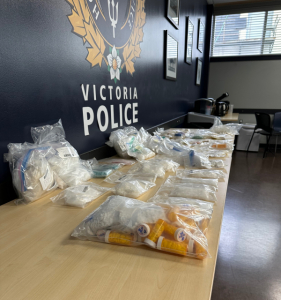 Township of Esquimalt: 2024 - Q2
Township of Esquimalt: 2024 - Q2
As part of our ongoing Open VicPD transparency initiative, we introduced Community Safety Report Cards as a way to keep everyone up to date with how the Victoria Police Department is serving the public. These report cards, which are published quarterly in two community-specific versions (one for Esquimalt and one for Victoria), offer both quantitative and qualitative information about crime trends, operational incidents, and community engagement initiatives. It is hoped that, through this proactive sharing of information, our citizens have a better understanding of how VicPD is working toward its strategic vision of “A Safer Community Together.”
Esquimalt Community Information
Overview
Q2 saw continued efforts by our Traffic Section to focus on community safety. They conducted pro-active work in the following three areas: impaired driving, school zone education and enforcement, and high visibility at several intersections and locations which have concerned community members.
In response to two consecutive weekends of youth violence in the Township, VicPD increased proactive patrols in the area. The enhanced visibility allowed for a quicker response to incidents. Noticeably, there were significantly fewer incidents involving youth after this measure was in place.
On May 2, we welcomed seven new recruits and on June 5 we welcomed two experienced officers to the VicPD family. Each recruit brings an extensive amount of volunteering and community service experience that will equip them to serve the communities of Victoria and Esquimalt.
To date, we have hired 14 new recruits and three experienced officers this year, with six more recruits to be sworn-in in September, and our January class quickly being selected. We’re very close to hiring 24 in ‘24 and with a goal of 30 new recruits in 2025, it’s still a great time to Join VicPD.

Reserves
Victoria Police Department currently has 75 reserve constables, with 10 recently graduating in June.

Missing Persons
From April 1 – June 30, Community Services Division handled 301 Missing Persons files, all of which were resolved. Having such a high success rate in reuniting missing people with their loved ones emphasizes VicPD’s commitment to ensuring reports of missing people are addressed in a timely and sensitive manner. We have dedicated Missing Persons coordinators responsible for the oversight and support functions for all missing persons’ investigations, ensuring that each file is reviewed, monitored and compliant with the BC Provincial Policing Standards. For more information, visit Missing People - VicPD.ca
Strike Force Covert Drug Trafficking Operation
In April, details were released from a covert Strike Force investigation that recovered over $48,000 worth in stolen merchandise and thousands of suspected opioid pills. During the investigation, which began in late February of 2024, the suspect was observed making several visits to a storage locker in Sooke. Investigators obtained a warrant to search the storage locker and located various illicit substances and approximately $48,000 worth of brand-new merchandise believed to be stolen, including:
- 4,054 suspected oxycodone pills
- 554 grams of cocaine
- 136 grams of methamphetamine
- 10 vacuums
- Five Kitchen Aid mixers
- A Milwaukee miter saw, chainsaws, drills, a metal detector and various other tools, clothing, and accessories


Calls for Service
In Q2 we saw a significant increase in calls for service in all areas except for Traffic. However, when comparing year-to-year, only calls for Social Order and Violence have a marked increase over the same period last year, while Traffic has a slight decrease. The total calls for service are higher than the same period last year.
Numerous incidents and calls required a significant amount of resources, most notably a shooting on Lyall Street on June 17.
Files of Note
Buccaneer Days Incidents | Files: 24-16290, 24-16321, 24-16323, 24-16328
VicPD officers investigated multiple disturbances caused by youth at and around the Buccaneer Days celebration. Youth were seen fighting and bear spraying each other, “swarming” and assaulting a man with a cane, stealing a fundraising box with over $1,000 in cash at the event, and bear spraying a female on a mobility scooter.
Second Consecutive Weekend of Youth Violence | Files: 24-17169, 24-17178
A group of youth approached another youth in the 1100-block of Esquimalt Road, bear sprayed them, then fled the area. Officers located the group, many of whom reside in the West Shore area. Later that same night, officers responded to a group of approximately 20 to 30 youths fighting, and one of the youths was bear sprayed. This marked the fifth reported incident of youth assaults involving pepper spray in one week. In response to the concerning uptick, VicPD increased proactive patrols in the Esquimalt area.
Prompt Response To Youth Crime | File: 24-18070
Despite a significantly higher proactive police presence in Esquimalt following the above incidents, a group of intoxicated youths caused challenges and attempted to break the outside windows of a business in the 900-block of Esquimalt Road. All the youths were identified, and a small canister of bear spray was located. The youths were released to their respective guardians on scene or transported home. Of note is that none of the identified youths reside in Esquimalt.
Police Respond To Violent, Naked Male In State Of Delirium | 24-16899
A male called police as his roommate was impaired by drugs, naked in the residence, violently smashing items and screaming incoherently. When members arrived at the Esquimalt residence, the suspect was very violent, unresponsive to voice commands and continued his behaviour. He then advanced on police and after a warning from the officer, a CEW (taser) was deployed but did not stop him. Two further CEW deployments were required to safely apprehend him, and he was transported to hospital.
Domestic Incident Turned Assault | 24-15663
The call came in as a domestic in progress with the suspects leaving the area in a red pickup truck. The two suspects, boyfriend and girlfriend, had been involved in a physical confrontation with the boyfriend’s family. The most serious offence occurred when the girlfriend struck the boyfriend’s mother in the face with a baton. The injuries resulted in a hospital visit but were non-life threatening. With assistance from the General Investigative Services (GIS) section, officers were able to identify the suspects and recommend charges to Crown counsel.
Major Crime Unit Investigating Shooting Incident | File: 24-21157
Patrol investigators responded to a report of multiple shots fired outside a residence in Esquimalt involving subjects known to the police. Shortly after Police received the call, two males arrived at VGH. Their vehicle had multiple bullet holes. The two occupants both had gunshot wound injuries. Police managed a large crime scene (including roadway) surrounding the Lyall Street residence. The file is still actively being investigated.
Inspector Brown continues to provide lockdown and security procedures for local infrastructure. Crime Prevention Through Environmental Design (CPTED) assessments are also provided to the community, with additional officers being certified to meet demand.
Senior Safety

Esquimalt Division Community Resource Officer (CRO) Ian Diack continues to develop relationships with the local seniors’ community and is actively involved in providing security and safety education to that critical part of the Township’s demographic. A World Elder Abuse Awareness Day event at the Esquimalt St. Peter and St. Paul Church was well attended, in collaboration with the BC Association of Community Response Networks. This was a great opportunity to connect with seniors in the community, which will be an ongoing focus area for the CROs.
Same Name, Same Message | Traffic Safety Campaign
In a cross-continental partnership, Public Affairs with Victoria Police (Canada) teamed up with Public Affairs from Victoria Police (Australia) to create a social media campaign highlighting traffic safety. The videos garnered a combined viewership of over 270,000 on Instagram alone.


Bait Bikes
Bait Bikes continue to be deployed throughout Victoria and Esquimalt to target prolific bike thieves.
Spring and summer are especially busy for Community Engagement. Officers, Reserves and Volunteers could be found throughout the community at festivals, fundraisers, memorials and sporting events. This summary does not include the daily and formal community engagement that takes place during patrols and other community safety work.
Sculpture Splash
Inspector Brown attended the Township Community Arts Council’s ‘Sculpture Splash’ event at the Gorge Pavilion in April. This was a fantastic opportunity for community members to socialize while appreciating a broad spectrum of incredible artwork.

April 13 – Esquimalt 5K
VicPD Reserves ran in the Esquimalt 5K (or did they provide support?)
April 13-15 Vaisakhi Day
VicPD officers and volunteers were at the Gurdwara on Sunday celebrating Vaisakhi with the Sikh community. Great to see so many families come to join the celebrations.

April 14-20 – National Volunteer Week
During this week we celebrated our 85+ VicPD Volunteers and 65+ Reserve Constables.

April 23 – Special Olympics Softball Game
VicPD are big supporters of Special Olympics, not only through the Polar Plunge in February, but throughout the year.
April 24-25 – VCPAA Youth Golf Tournament
The Victoria City Police Athletic Association hosted a rainy golf tournament at Olympic View Golf Course. Open to high school students throughout British Columbia, the purpose of the tournament is to foster positive relationships between the police and the youth of our community, while supporting youth in achieving excellence in sport. The two-day tournament has been running since 1985 and hosted over 130 students representing 23 different schools across British Columbia.

April 28 – TC 10K
This year, the VicPD “Keepers of The Pace” team joined the TC 10K run, while VicPD officers kept the event safe.
April 28 – Khalsa Days Parade and Vaisakhi Celebration
VicPD officers, Reserves and volunteers supported the Khalsa Day Parade. VicPD had an information booth and was able to engage with the community and ensure the event proceeded safely.

Tim Horton’s Smile Cookie Event
From April 29 to May 5, Tim Horton’s hosted the annual Smile Cookie program, where 100% of the proceeds go to local charities and community groups. Our local Tim Horton’s raised over $28,000!

May 8 - McHappy Day Charity Event
Esquimalt Division’s CROs worked alongside McDonald’s staff for their annual McHappy Day charity event.

May 10-11 Buccaneer Days Weekend
Chief Manak, Deputy McRae, Insp. Brown and a number of VicPD reserves & volunteers participated in the Buccaneer Day Parade. This was a great community event with an outstanding turn out by our local community members and families.

May 18 – Victoria Highland Games
VicPD Volunteers provided community safety and crime prevention education to community members at the VicPD booth.
May 20 – Victoria Day Parade
VicPD officers, Reserves and Volunteers once again proudly participated in the Victoria Day Parade while officers and Reserves worked to ensure the event remained safe and fun for all.
June 1 – Law Enforcement Torch Run
VicPD officers participated in the annual Law Enforcement Torch Run to raise awareness and funding for our B.C. Special Olympic athletes.

June 8 – Graffiti Paint-Over
Officers, Reserves and Volunteers participated in painting over graffiti in the Burnside-Gorge area.

June 8 – Change Makers Gathering
Officers brought the VicPD Canoe to this annual gathering.
June 8 – Esquimalt Neighbourhood Party
VicPD Volunteers provided community safety and crime prevention education to community members at the VicPD booth.
June 15 – World Elder Abuse Awareness Day
Cst. Ian Diack attended a pancake breakfast and presented information on fraud prevention.
June 9 – Mabuhay Philippine Festival
VicPD Volunteers provided community safety and crime prevention education to community members at the VicPD booth.
June 21 – National Indigenous People’s Day
Officers raced the VicPD canoe at a celebratory event held at Royal Roads University.
June 25 – NHL Street Kickoff
The second season of NHL Street started with 160 youth participants. Sponsored by VicPD, the Victoria City Police Athletic Association and the Victoria Royals, NHL Street ran Tuesdays until July 30.
June 27 – Pride Flag Raised
The progressive pride flag was raised for the second year at VicPD headquarters on Caledonia Avenue.
June 18 - Community Living Tour
Esquimalt Division hosted a tour for participants in the day program at Community Living Victoria

At the end of the second quarter, the net financial position is approximately 55% spent of the total budget, which is slightly over budget but reasonable, taking into consideration that benefit expenditures are higher for the first two quarters of the year due to CPP and EI employer deductions. Also, the Department incurred $656,000 in retirement expenditures due to many requirements occurring early in the year. These expenses have no operating budget, and if there is an insufficient surplus to cover these expenditures at year-end, they will be charged against the employee benefit liability fund.
